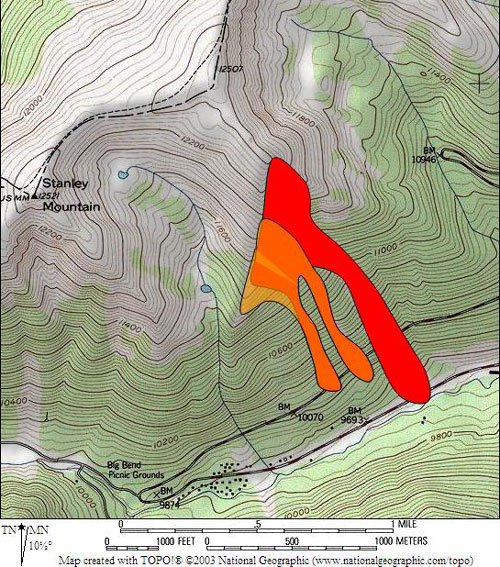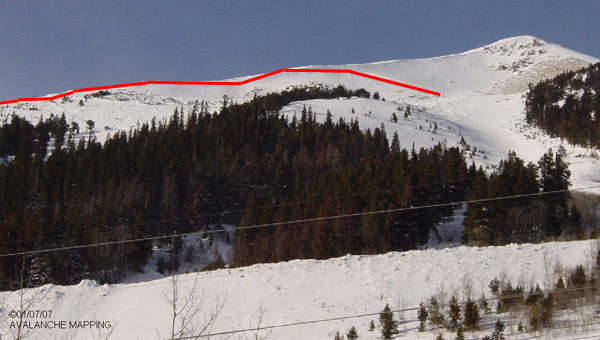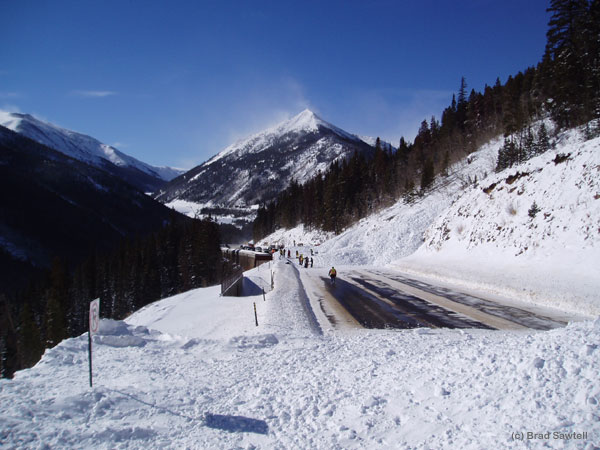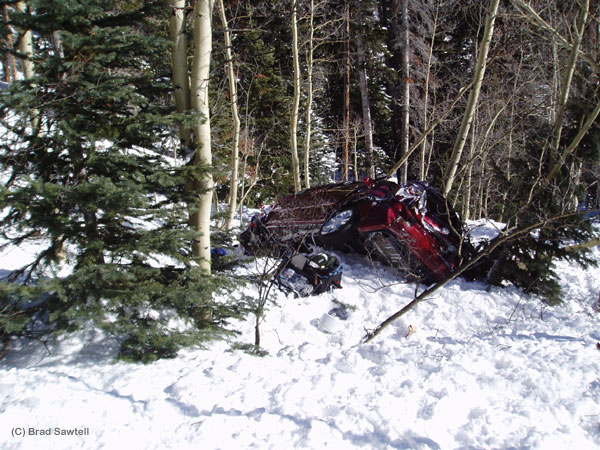
On January 6, 2007, at approximately 10:20 in the morning, the Stanley slide path near Berthoud Pass avalanched putting debris on U.S. Highway 40 (US40). The Stanley slide path crosses two switchbacks of US40. The avalanche debris pushed two vehicles off the upper section of the roadway and partially buried them between the two switchbacks. Five people were riding in one vehicle and three in the other. Witnesses initiated a rescue of the vehicle occupants. Staff members of the Colorado Avalanche Information Center (CAIC), Colorado Department of Transportation (CDOT) and Alpine Rescue Team were in the area and initiated an organized rescue of the victims and search of the debris. The organized search and evacuation of the victims was completed in conjunction with the Clear Creek Sheriff's Office, Colorado Highway Patrol and various emergency service agencies.
Moderate amounts of new snow accumulated through the end of December. The next major snowfall of 9.5 inches occurred on January 5, 2007. On the morning of January 6, 2007, northwest winds increased into the 30 mph range with gusts into the 60s.
The Stanley avalanche was a hard slab avalanche, triggered by a natural loading event. It was a moderate sized avalanche relative to what the slide path could produce, and had enough destructive force to destroy a car or wood framed building. The avalanche involved both new and old snow layers. Given these parameters, the avalanche classification for this event is HS-N-R3D3-O.

The Stanley slide path (in red), and the approximate outlines of the avalanche on Jan 6 (orange).
The Stanley avalanche path is a very large path that historically has crossed both sections of highway and deposited debris near the drainage bottom. In this event, the debris did not run full track into the runout zone of the avalanche path. Rather, the debris stopped in the track. In addition, a large portion of the east side (viewer's right) of the start zone did not avalanche. Although this was a large avalanche with significant destructive force, it was a moderate sized event compared to what this avalanche path could produce.
The fracture line of the avalanche on January 6, 2007 was over 1000 feet wide. We estimated the depth of the fracture to be between 2 and 10 feet deep. A large portion of the start zone did not release during the avalanche, but the fracture line extended well beyond the right flank (looker's left side) of the avalanches often observed in this path.


A photo of the crown, taken several days later. The main avalanche path runs from the upper right of the photo towards the lower left.
It is neither practical nor safe to observe regular snow profiles in the start zone of the Stanley avalanche path. Therefore, the CAIC/CDOT forecasting staff uses a study site approximately 1.5 miles to the northeast of the Stanley path. This study site has the same aspect and elevation of the start zone of the Stanley path. The snowpit below describes the snowpack at the study site on January 8, 2007.

The basal layer was faceted snow with a discontinuous, eroded crust at the top. The mid portion of the snowpack was a hard layer of rounded grained snow grains. The upper portion of the snowpack was a hard layer of dense snow that most likely formed during the wind event on January 6. Under this wind slab there was a thin, softer layer of decomposing precipitation particles. This relatively soft layer separated the upper wind slab from the older hard slab in the middle of the snow profile.
It is impossible to reconstruct completely the events that produced the avalanche in the Stanley slide path. However, we can make some educated guesses from snow and avalanche observations at nearby sites. During the avalanche cycle that followed the Stanley avalanche, several large avalanches initiated in the new windslab, and then stepped down into deeper layers. It is possible that the avalanche in the Stanley path progressed in a similar manner. As the wind slab ran through the path it triggered a larger avalanche that broke into old snow layers. The stratigraphy observed in the profile on January 8, 2007 shows that this scenario was possible. On January 6, 2007, it is unlikely that a new snow avalanche in the Stanley path could have reached the road. However, if a natural avalanche in the recently deposited wind slab triggered a much larger old snow slide, the debris would have contained enough mass to reach the roadway.
The avalanche occurred at approximately 10:20 in the morning on January 6, 2007. Witnesses with cell phones on US40 alerted the emergency services system almost immediately. The local 911 dispatch contacted CAIC and CDOT personnel who closed the road and traveled to the debris pile to begin search and rescue operations. The Alpine Rescue Team was conducting avalanche training with CAIC staff on Berthoud Pass that morning. They abandoned their training and headed to the accident site to aid search and rescue operations.

Avalanche debris completely blocked the road. The track of the Stanley path has three distinct branches. The two eastern most branches created piles of debris on the roadway. The vehicles were caught in the debris flowing out of the middle branch of the avalanche path. The avalanche pushed two vehicles off the roadway and down the steep slope between the two switchbacks of US40. Witnesses of the avalanche initiated a rescue immediately after calling 911. Portions of the two vehicles were protruding through the debris making it relatively easy for the rescuers to locate the vehicles and extricate the victims. One of the victims was partially buried in the car and could not be extricated until her seat belt was cut and removed. The windshield of the other vehicle was removed to create an exit for the occupants.

All of the victims suffered numerous bruises and small lacerations. One of the victims could not walk up the debris to the road and was raised up the slope by rescuers. This person was hospitalized and media sources reported the victim sustained broken ribs. All of the other victims were able to walk up to the roadway. They were transported from the site for medical care and released on the afternoon of January 6, 2007.
The last time the Stanley Path avalanched and caught a vehicle was in 1988. The slide struck a van, pushed it off the road, and buried the driver to his neck. Ironically, a few minutes before the driver had heard a radio bulletin about the current avalanche danger. A natural avalanche struck and killed one motorist in 1945. Apparently the avalanche occurred late at night.
Greene, 2007 01/31